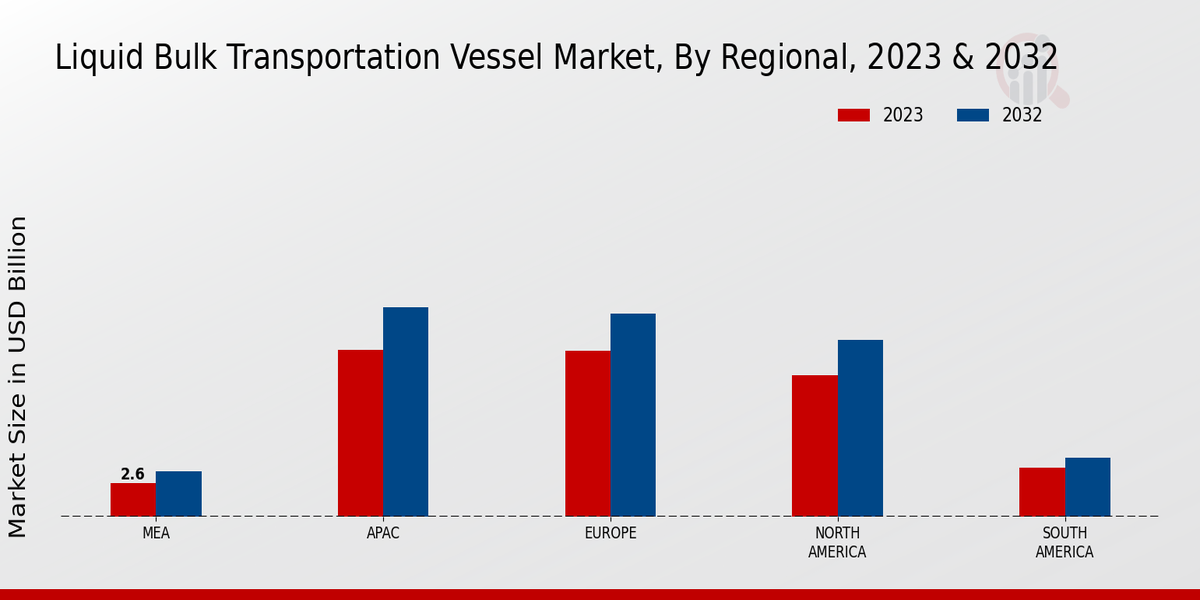Chart of Market Growth Projections
The Global Liquid Bulk Transportation Vessel Market Industry is projected to experience substantial growth over the next decade. The market is expected to reach 43.7 USD Billion in 2024 and is anticipated to grow to 59.9 USD Billion by 2035. This growth trajectory indicates a compound annual growth rate of 2.92% from 2025 to 2035, reflecting the industry's resilience and adaptability to changing market dynamics. The accompanying chart illustrates these projections, highlighting the steady increase in market value and the factors contributing to this upward trend.
Growing Demand for Liquid Bulk Commodities
The Global Liquid Bulk Transportation Vessel Market Industry experiences a notable surge in demand for liquid bulk commodities such as chemicals, oil, and liquefied natural gas. This trend is driven by the increasing consumption of these commodities across various sectors, including energy, manufacturing, and agriculture. As economies expand, the need for efficient transportation of these liquids becomes paramount. In 2024, the market is projected to reach 43.7 USD Billion, reflecting the industry's capacity to adapt to rising demands. This growth trajectory suggests a robust future, with the market expected to reach 59.9 USD Billion by 2035, indicating a sustained interest in liquid bulk transportation solutions.
Expansion of Global Trade and Supply Chains
The expansion of global trade and supply chains is a pivotal driver for the Global Liquid Bulk Transportation Vessel Market Industry. As international trade continues to flourish, the demand for efficient transportation solutions for liquid bulk goods rises correspondingly. This trend is particularly evident in emerging markets, where increased industrialization and urbanization lead to higher consumption of liquid commodities. The interconnectedness of global markets necessitates reliable shipping routes and logistics, thereby boosting the need for specialized vessels. The anticipated growth in trade volumes is expected to contribute to the market's expansion, with projections indicating a compound annual growth rate of 2.92% from 2025 to 2035.
Technological Advancements in Vessel Design
Technological innovations play a crucial role in enhancing the efficiency and safety of the Global Liquid Bulk Transportation Vessel Market Industry. Modern vessels are increasingly equipped with advanced navigation systems, automated cargo handling, and improved hull designs that reduce fuel consumption and emissions. These advancements not only optimize operational efficiency but also align with global sustainability goals. As regulations become stricter, companies investing in state-of-the-art vessels are likely to gain a competitive edge. The integration of these technologies is expected to facilitate the growth of the market, ensuring that it meets the evolving demands of the industry while maintaining compliance with environmental standards.
Regulatory Compliance and Environmental Standards
The Global Liquid Bulk Transportation Vessel Market Industry is significantly influenced by stringent regulatory frameworks aimed at ensuring environmental protection and safety. Governments worldwide are implementing regulations that mandate the use of eco-friendly technologies and practices in the transportation of liquid bulk. Compliance with these regulations often requires substantial investment in fleet upgrades and retrofitting existing vessels. While this may pose challenges for some operators, it also presents opportunities for growth as companies that prioritize sustainability can enhance their market position. The ongoing evolution of these regulations is likely to shape the industry's landscape, pushing for innovations that align with global environmental objectives.





















